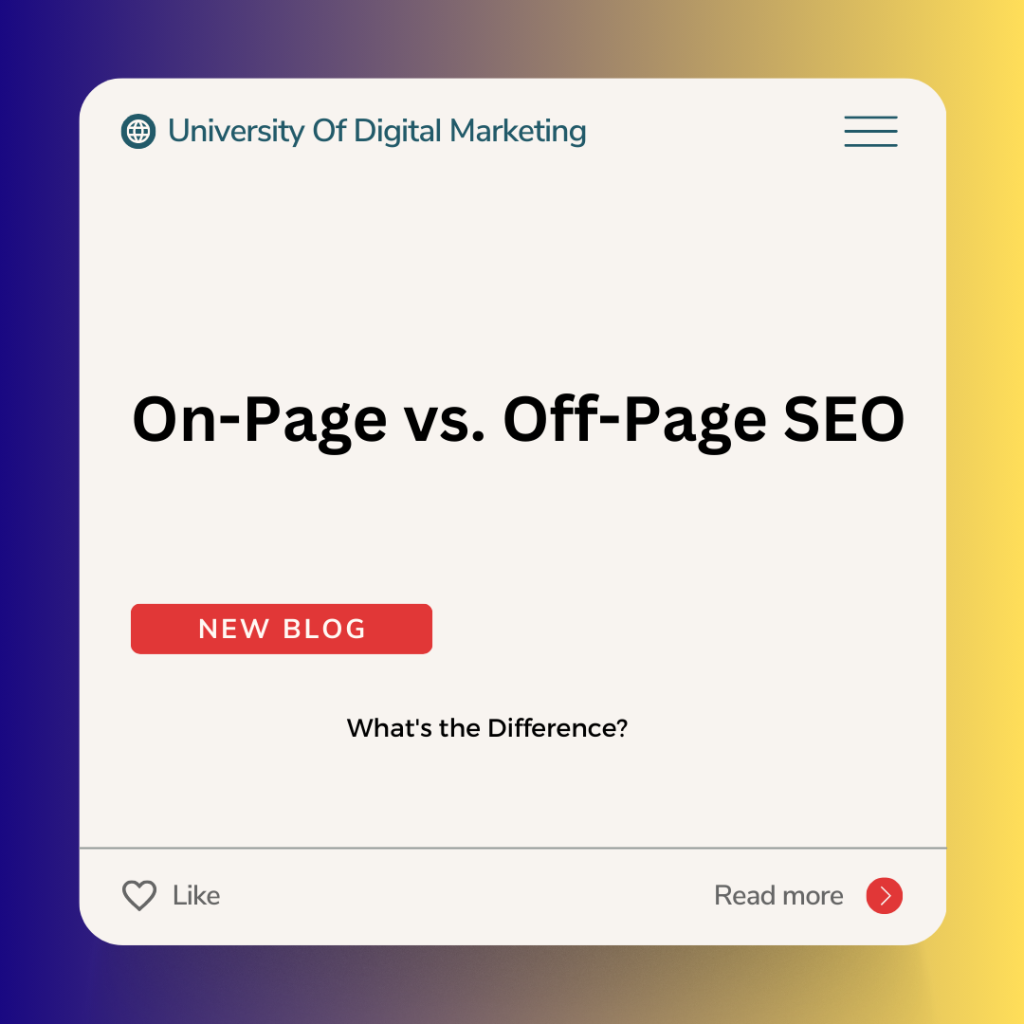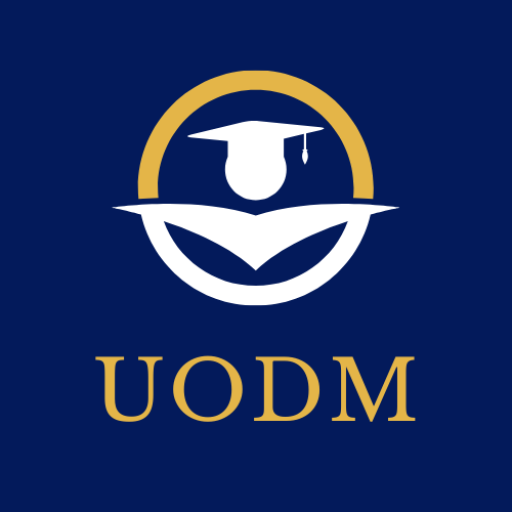In the ever-evolving realm of digital marketing, where websites vie for prime real estate on search engine results pages (SERPs), Search Engine Optimization (SEO) reigns supreme. But SEO itself is a multifaceted beast, demanding a two-pronged approach: on-page and off-page optimization. Understanding the distinct roles they play is crucial for crafting a winning SEO strategy.

On-Page SEO: Optimizing Your Internal Landscape
Imagine your website as a well-organized store. On-page SEO is akin to meticulously arranging your products (content), labeling them clearly (keywords), and ensuring a smooth customer experience (website usability). It encompasses all the elements within your website’s control that influence search engine ranking. Here’s a breakdown of key on-page SEO tactics:
Content is King (and Queen): High-quality, informative, and engaging content forms the cornerstone of on-page SEO. Here’s a deeper dive into crafting content that search engines and users love:
Keyword Research:
Identify relevant keywords: Utilize keyword research tools like Google Keyword Planner, Ahrefs, SEMrush, or even free options like AnswerThePublic and Google Trends. These tools allow you to enter seed keywords related to your niche and generate a list of related keywords, along with their search volume, competition level, and other insights. Prioritize user intent when selecting keywords. Ask yourself: what is the user’s goal when searching for this keyword? Are they looking for information, trying to compare products, or ready to make a purchase? Tailor your content to address their specific needs and intent. For instance, if you’re targeting the keyword “best running shoes for beginners,” your content should focus on providing informative comparisons and buying guides, rather than technical specifications that might overwhelm a beginner.
Content Quality and Structure:
Focus on quality: Create high-quality content that is well-written, informative, valuable to your target audience, and at least 300 words long (ideally longer for informative content). Avoid thin content or keyword stuffing, as search engines penalize such practices.
Structure for readability: Break down your content into clear and concise sections using headings (H1-H6), subheadings, and bullet points. This improves readability for users and helps search engines understand the content’s hierarchy and key points. Use transition words and phrases to create a logical flow between ideas.
Titles, Meta Descriptions, and Internal Linking:
Crafting compelling titles and meta descriptions is an essential part of on-page SEO. Titles should be concise, informative, and relevant to the target keyword, while meta descriptions should act as mini-ad copy, summarizing the page’s value proposition and encouraging clicks. Here’s a step-by-step guide to optimizing these elements using the Rank Math plugin for WordPress:
While editing a page or post: Scroll down to the Rank Math SEO metabox.
Craft your title: Aim for a title between 50-60 characters. Include the target keyword naturally within the title, but avoid keyword stuffing.
Write a compelling meta description: Keep your meta description between 150-160 characters. Briefly summarize the page’s content and highlight its benefits to entice users to click. Naturally incorporate the target keyword here as well.
Monitor character counts: Rank Math displays a live character count for both titles and descriptions, helping you stay within the recommended limits.
Internal linking is another crucial on-page SEO strategy. It involves linking relevant pages within your website using descriptive anchor text. This helps users navigate your site, distributes link equity (importance) throughout the site, and signals to search engines the relationships between different pages. Here are some best practices for internal linking:
Use a mix of anchor text types: Avoid using the exact-match keyword for every link. Instead, employ a combination of exact-match, partial-match, and brand-name anchor text to appear natural.
Link to relevant content: Only link to pages that are topically relevant to the current page. Irrelevant links can confuse users and search engines.
Prioritize high-quality pages: Link to your most valuable and informative pages to distribute link equity more effectively.
Rank Math also provides internal linking suggestions within the SEO metabox. As you type your content, Rank Math will suggest relevant pages on your website that you can link to. This makes it easy to build a strong internal linking structure and improve website navigation.
Image Optimization:
Optimize filenames: Use descriptive filenames that accurately reflect the image content, instead of generic names like “IMG_001.jpg”.
Write descriptive alt tags: Include alt tags for all images, providing a concise description of the image content. This helps visually impaired users understand the image and improves accessibility. Additionally, search engines can use alt text to understand the context of the image and improve image search ranking.
Compress images: Optimize image sizes for faster loading speeds. There are many free and paid tools available online to help you compress images without compromising quality. This is crucial, as website speed is a significant ranking factor.
Mobile-First Friendliness and Technical SEO:
Ensure mobile-friendliness: Use a responsive web design or a dedicated mobile website to ensure your website displays flawlessly across all devices. Google prioritizes mobile-friendly websites in search results.
Address technical SEO aspects: While not directly visible to users, technical SEO factors like website speed, structured data markup, and robot.txt files play a crucial role in search engine crawlability and indexation. If you’re not familiar with technical SEO, consider consulting an SEO specialist or using website auditing tools to identify and address any technical issues. These technical aspects are essential for ensuring search engines can properly crawl and understand your website.
Off-Page SEO: Building Authority and Trust
Off-page SEO ventures beyond your website’s boundaries, focusing on building its reputation and authority in the online landscape. It’s like earning positive word-of-mouth recommendations for your store, attracting more customers (traffic) and influencing search engine perception. Here are some key off-page SEO strategies:
Backlink Bonanza: Backlinks are essentially votes of confidence from other websites. High-quality backlinks from relevant and reputable websites send a strong signal to search engines that your content is valuable.
Content Marketing Marvels: Create informative and shareable content (articles, infographics, videos) that gets people talking and linking back to your site.
Social Media Savvy: Leverage the power of social media platforms to promote your content, engage with your audience, and build brand awareness. Social shares can also indirectly influence search engine rankings.
Guest Blogging: Contribute guest articles to established websites in your niche. This not only positions you as an expert but also earns you valuable backlinks.
Online Reputation Management: Actively monitor and address online reviews and mentions of your brand. A positive online reputation builds trust and signals authority to search engines.
The SEO Symphony: A Harmonious Blend
On-page and off-page SEO are not rivals; they are partners in a beautiful SEO symphony. While on-page SEO optimizes your website for search engines, off-page SEO amplifies its reach and credibility. Here’s how they work together:
Strong On-Page Foundation: A well-optimized website with high-quality content provides a solid foundation for off-page efforts. Search engines are more likely to consider websites with strong on-page SEO for backlinks and ranking.
Off-Page Amplification: Off-page SEO, particularly backlinks from authoritative sites, signals to search engines that your website is valuable and trustworthy. This, in turn, can significantly boost your website’s ranking potential.
Finding the SEO Sweet Spot
The ideal balance between on-page and off-page SEO can vary depending on your website, industry, and competition. However, a good starting point is to focus on creating high-quality content and optimizing your website for on-page SEO factors.
FAQ in Onpage and Offpage SEO
- What is On-Page SEO? On-Page SEO refers to the optimization techniques implemented directly on a website to improve its search engine rankings. This includes optimizing content, HTML source code, and other elements to make the site more search engine-friendly.
- How important are Meta Tags for On-Page SEO? Meta tags, including title tags and meta descriptions, play a crucial role in On-Page SEO. They provide information to search engines about the content of a page, influencing click-through rates and search rankings.
- Is Content Quality important for On-Page SEO? Yes, high-quality and relevant content is paramount for On-Page SEO. Search engines prioritize content that is valuable, informative, and addresses the user’s intent. Quality content helps improve user engagement and search rankings.
- What is the significance of URL structure in On-Page SEO? A well-structured URL contributes to a better user experience and is favored by search engines. Descriptive and SEO-friendly URLs can improve click-through rates and search rankings.
- How does Page Speed affect On-Page SEO? Page speed is a crucial factor for On-Page SEO. Faster-loading pages enhance user experience, reduce bounce rates, and positively impact search rankings. Google considers page speed in its ranking algorithm.
Off-Page SEO FAQs:
- What is Off-Page SEO? Off-Page SEO involves activities outside of the website to improve its visibility and authority. This includes link building, social media marketing, and other external efforts to boost a site’s reputation.
- How important are Backlinks in Off-Page SEO? Backlinks are crucial in Off-Page SEO. They serve as “votes of confidence” from other websites, indicating the site’s credibility and authority. Quality backlinks positively influence search engine rankings.
- What is the role of Social Media in Off-Page SEO? Social media presence is a significant factor in Off-Page SEO. Social signals (shares, likes, comments) contribute to a site’s credibility. Additionally, social media platforms can drive traffic and indirectly impact search rankings.
- How does Online Reputation Management relate to Off-Page SEO? Managing and maintaining a positive online reputation is part of Off-Page SEO. Positive reviews and mentions contribute to a site’s authority, while negative content can have adverse effects on search rankings.
- Is Guest Blogging still effective for Off-Page SEO? Guest blogging can be effective if done strategically. Quality guest posts on reputable sites can build backlinks and establish authority. However, spammy or low-quality guest blogging can have a negative impact, so it’s crucial to focus on relevance and quality.

